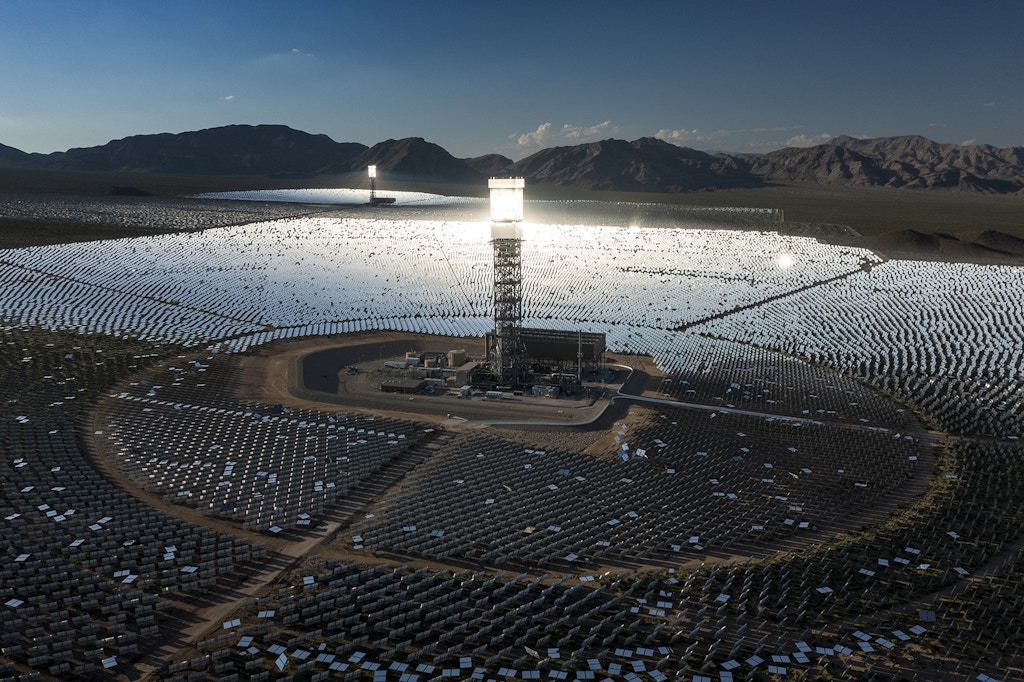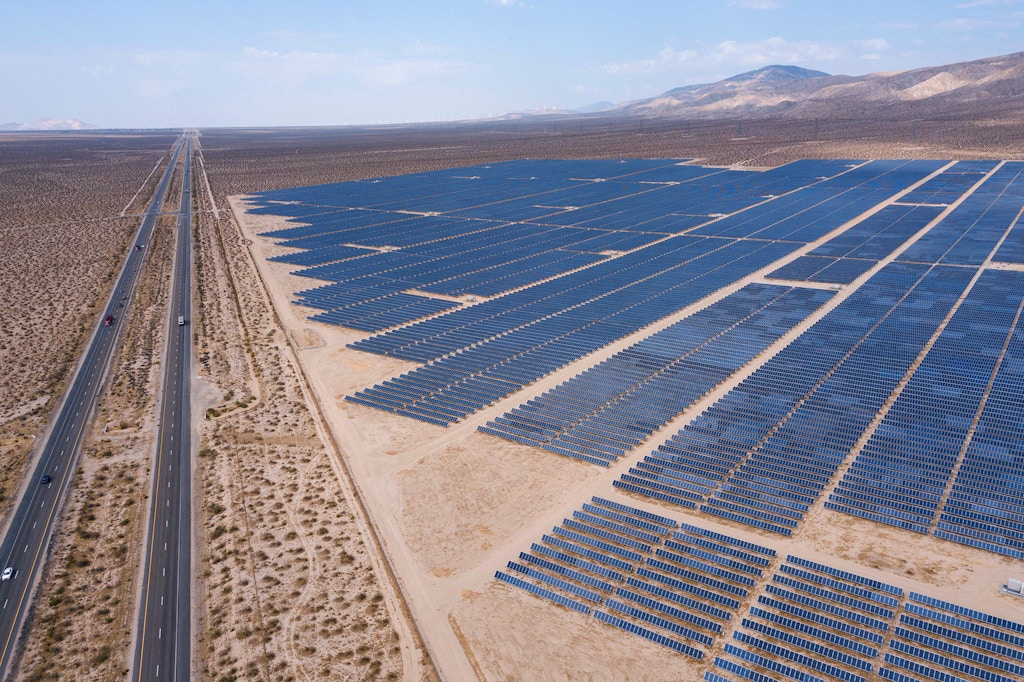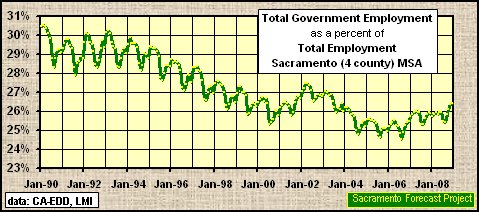
A boiler tower surrounded by mirrors at the Ivanpah Solar Electric Generating System in the Mojave Desert, Calif., on Aug. 26, 2022.
Photo: David McNew/Getty Images
This might explain the discipline’s desperate hitching of its wagon to the climate movement. Climate, after all, is the environmental cause du jour, eclipsing all other sustainability concerns, increasingly attractive as a rallying cry for a public that has canonized it as one of the major political, social, and economic issues of our time. Mainstream climate activism of the Bill McKibben variety points toward a grandly hopeful end within the confines of acceptable capitalist discourse: decarbonization of the global economy, with technologies driven by profit-seeking corporations subsidized by governments. Taking up this banner of optimistic can-do-ism, the environmental movement has convinced itself, and sought to convince the public, that with a worldwide build-out of renewable energy systems, humanity will power its dynamic industrial civilization with jobs-producing green machines while also — somehow — rescuing countless species from the brink.
“But this happens to be a lie,” Ashe told me. “The lie is that if we address the climate crisis, we will also solve the biodiversity crisis.”
“The lie is that if we address the climate crisis, we will also solve the biodiversity crisis.”
A group of conservationists took up the question of climate and extinctions last year in the journal Conservation Letters, warning that “threats to biodiversity are increasingly seen through the single myopic lens of climate change.” The authors, who titled their article “An inconvenient misconception: Climate change is not the principal driver of biodiversity loss,” included Joel Berger, a wildlife biologist at Colorado State University; evolutionary biologist Andrew Dobson, who teaches at Princeton; and Tim Caro, an evolutionary ecologist at the University of California, Davis. “There is an assumption,” they observed, “that climate change is now the most important ‘horseman of the biodiversity apocalypse’” — despite this being “at best premature.”
When it comes to effects on wildlife, climate change is more like a mule, slow and plodding. Yes, a warmed atmosphere is projected to be a significant factor in the extinction crisis in future decades, but what’s destroying species today is habitat fragmentation and loss, overhunting and overexploitation, agricultural expansion, pollution, and industrial development. It isn’t climate change that caused a 69 percent loss in total wildlife populations between 1970 and 2018, according to a World Wildlife Fund study published this year. The cause is too many people demanding too much from ecosystems, or human overshoot of the biophysical carrying capacity of the Earth.
Overshoot is a product of both excessive numbers and rising affluence. Access to the things that create what we call quality of life, like indoor lighting and temperature controls, especially air conditioning; more diverse dietary choices, especially meat; and greater access to transportation, especially air travel — all signs of rising affluence, all delightful if you are a human, yet all demand more energy and material inputs that involve scouring and denuding more wildlands and animal habitat to feed, clothe, house, and energize burgeoning humanity.
According to the co-authors of the Conservation Letters piece, we are “dangerously ignoring” this reality and instead doubling down on the “distortion” that climate mitigation is all that matters to protecting wildlife. Over the last 30 years, the proportion of scientific papers closely tying climate change and global warming to changes in patterns of biodiversity has “steadily increased,” according to their analysis. Media coverage of climate change in relation to biodiversity has followed suit, repeating and compounding the error. The net result of this “misguided focus on climate change” has been the undermining of conservation science “as an evidence-based scientific discipline.” As Dobson put it to me, “If conservation biologists don’t take a balanced look at the evidence, they can’t claim to be evidence-based.”
The crux of the problem is that mainstream environmentalists have siloed climate change as a phenomenon apart from the broad human ecological footprint, separate from deforestation, overgrazing of livestock, megafauna kill-off, collapsing fisheries, desertification, depleted freshwater, soil degradation, oceanic garbage gyres, toxification of rainfall with microplastics, and on and on — the myriad biospheric effects of breakneck growth. Climate change is “but one symptom of an environmentally dysfunctional system of constant growth of economies and populations,” ecologist William Rees, professor emeritus at the University of British Columbia, told me.
“The meta-problem that we need to keep our eyes on,” Rees said, is ecological overshoot. Modern techno-industrial culture, he writes, “is systematically — even enthusiastically — consuming the biophysical basis of its own existence.” Rees describes this as a malignant process, humanity as cancer.
Rees is hardly alone in his stark assessments of the status quo. In the most recent letter of “world scientists’ warning,” a semiannual notice to the public, 12 experts in life sciences, global system dynamics, and ecology noted that “most planetary boundaries that regulate the state of the Earth are beyond their safe space. Therefore, climate change is not a stand-alone issue. It is part of a larger systemic problem of ecological overshoot.”
The authors added the commonsense observation that humanity “cannot sustain unlimited growth in a finite world,” a physical law of life on Earth that we ignore at our peril.

Photo: Patrick T. Fallon/AFP via Getty Images
Solar and wind occupy much larger acreage than oil and gas, requiring networks of roads and utility corridors, transportation and transmission capacity that doesn’t exist today. Environmental lawyer Michael Gerrard, founder and director of the Sabin Center for Climate Change Law at Columbia Law School, estimates that the U.S. needs a tripling or even quadrupling of transmission capacity — up from the 160,000 miles of high-voltage power lines now in operation — to move all the new green energy to consumers, who are mostly in cities, from the remote places where it’s harvested.
A report for the Brookings Institution states that wind and solar require 10 times more land per unit of power produced than coal- or natural gas-fired power plants, a figure that takes into account the land torn up and habitat destroyed in order to drill out, pump, and transport fossil fuels. “Renewable power production,” the report states matter-of-factly, “will take place in areas that have not seen energy development.”
There is also the global scale of mining needed to extract and process the lithium, nickel, cobalt, rare earths, and other necessities for renewables infrastructure. The net result: Decarbonizing will likely lead to huge fragmentation of land, in the U.S. and overseas, particularly in minerals-rich China and the “global south.” And not just wildlife will be affected: The “death villages” around the Bayan Obo mine in China, source of 70 percent of the world’s rare earths, are testament to the health cost of green-tech mining, which is only going to accelerate in pace and scale.
Consider the green destruction of habitat now unfolding in the Mojave Desert across California and Nevada, where the rush to build industrial solar is catastrophic for native flora and fauna. “Utility-scale solar is just as bad as urbanization and development,” said Patrick Donnelly, who works at the Center for Biological Diversity investigating the environmental effects of the renewable energy rush in the American West. “The result is that the Mojave is in big trouble.”
Start with site-specific Mojave plant species such as the tricorner milkvetch and the white-margined beardtongue, lovely rare flowers endemic only to certain valleys and basins. They are goners under the solar regime. From there the picture only gets uglier, with the likely wiping out of huge stretches of habitat for the broad suite of Mojave fauna: foxes, hawks, badgers, rabbits, and, most prominently, the desert tortoise, the keystone species of the Mojave, whose construction of extensive burrows provides homes for at least a dozen other species. “If there were no desert tortoises to dig new burrows,” states a Fish and Wildlife Service manual about the species, it would lead to “the demise of the ecosystem.”
“The worst thing these massive solar projects do is cause direct habitat loss for the tortoise and friends,” Donnelly told me. The grim future that rampant solar development promises for Mojave wildlife is already in evidence where migratory passages for tortoises have been compromised by existing solar. Climate change modeling tells us the optimal temperature range for the tortoise is moving steadily northward, and so the tortoise will seek the path north to survive. Critical passages for this expected migration have been cut off. Ivanpah Valley, a bottleneck between the east Mojave and the north Mojave, is now severed by solar. Pahrump Valley, another passage to the north, is slated for solar that will have a similar blockading effect. There are tens of thousands of acres in the Mojave Desert containing what the U.S. Bureau of Land Management calls “high density populations” of desert tortoise that are now being developed for solar, with the expected result, according to Donnelly and other watchdogs, that tortoises there will wink out.
Some 60,000 acres of BLM land adjacent to near-pristine Death Valley National Park have been proposed for industrial solar. One of the sites is Sarcobatus Flat, a wild place mostly empty of human habitation, which is a value in itself, as wildlife needs big open spaces free of the meddling of Homo sapiens. Situated in the Great Basin-Mojave transition zone, Sarcobatus is a vast valley of Joshua trees, greasewood, and blackbrush. The Joshua tree, which the Fish and Wildlife Service is considering for protection under the Endangered Species Act, is on a path to extinction, Joshua tree woodlands being one of the most imperiled ecosystems in the American West. The solar project at Sarcobatus Flat would kill, bulldoze, and stack in cordwood piles between 50,000 and 70,000 of the trees, according to a field estimate by the nonprofit Basin and Range Watch.
The Great Basin Desert to the north, meanwhile, remains mostly free of the techno-industrial regime. But that’s ending with the advent of new electrical transmission projects into these remotest parts of Nevada, a project called Greenlink that electricity and natural gas provider Nevada Energy is funding. Greenlink North, pending approval, is planned to run along Highway 50, the famous Loneliest Road in America, from Reno to Ely, through some of the wildest parcels of public land in the state — and prime habitat of the endangered greater sage-grouse. This ground-nesting bird, like the desert tortoise, is an indicator species of landscape health.
The purpose of the transmission line, as Nevada Energy has made clear, is to render solar economically feasible in those remote sun-rich landscapes. Greenlink North, along with the associated solar fields it will make possible, is expected to devastate some of the last strongholds of sage-grouse in north-central Nevada, as the birds are exquisitely sensitive to the light and noise of development.
We will be a kind of gleaming metallic Noah’s Ark that carries few animals, only lots of people.
It may be that global society can achieve a measure of sustainability in climate terms — but on a planet that has been stripped of creatures like the tortoise and the sage-grouse, shorn of natural agency, reduced to a biological pauper, its last wildernesses occupied for the greater good of the industrial juggernaut. We will be a kind of gleaming metallic Noah’s Ark that carries few animals, only lots of people.
Pondering these matters, Dan Ashe had arrived at a revelation that amounted to a conservation biologist’s worst nightmare. “I’ve come around to the idea that a lot of the diversity of life on Earth may be incompatible with human ambitions and aspirations. On the other hand,” he told me, “I can be very optimistic about climate because ultimately humanity is going to deal with carbon pollution. It’s an issue for our well-being. We can solve it by building machines and making money. That’s obvious in the Inflation Reduction Act. … But with the biodiversity crisis, you can’t solve it with machines, and it involves constraints on our making money. And history shows we aren’t very good at constraint.”
Ashe suggests that conservation biologists cease the empty claims about “saving the planet” with climate mitigation and start speaking truth: There is at present no plan, in any country, anywhere, on a global or national scale, to address extinctions, biodiversity crash, and habitat loss. The dismal reality is that with a green build-out, we will be saving not the complex web of life on Earth but the particular way of life of one privileged domineering species that depends for its success on a nature-ravaging network of technological marvels. Only once this truth is understood can honest decisions be made about what kind of world humanity wishes to inhabit in the age of ecological disorder.






More Stories
Digital Law Firm Marketing: Best Techniques for Online Growth
Choosing the Right Louisiana Property Damage Attorney: A VITAL Guide
Get Ready for Success: Dive Bomb Industries Waterfowl Gear Explained